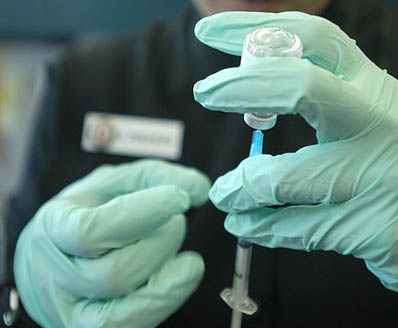January 13, 2017

A weekly roundup of news on drug resistance and other topics in global health.
DPT3 non-vaccination and dropout before third dose among children in India. CDDEP Director Ramanan Laxminarayan and co-author Arpita Ghosh analyzed the factors associated with both DPT nonvaccination and vaccination dropouts—children who received only one or two doses, but not all three required for full protection. The study, published in Vaccine, looked at “demand-side factors”—mainly family characteristics, and “supply-side factors”—related mainly to healthcare access associated with both nonvaccination and vaccination dropouts. They analyzed data from more than 75,000 infants in villages across India, from the District Level Household and Facility Survey (DLHS-3), conducted during 2007-2008. Both demand- and supply-side factors had an effect, with the demand-side effects somewhat stronger. Among their key findings: children whose mothers had no schooling were two to three times more likely not to receive any DPT vaccination and 2.5 times more likely to drop out between doses one and three, compared with children whose mother had 10 or more years of schooling; and children in districts where at least 46 percent of villages had a healthcare subcentre were 1.5 times more likely to receive at least one dose of DPT vaccine, compared with children in districts where 30 percent or fewer villages had subcentres. [Vaccine]
CDDEP Associate Director for Policy Hellen Gelband profiled in The Lancet. Richard Peto, Professor of Medical Statistics and Epidemiology at the University of Oxford, UK, writes, “Even the best medicines don’t work if they’re not used, and Hellen Gelband has helped people to develop practicable strategies such as the Drugs for Neglected Diseases Initiative or AMFm for getting effective medicines affordably available worldwide, including DEC salt for filariasis control and opioids for cancer palliation. For decades she has been a quietly effective enforcer of clear thinking, clear writing, scientific accuracy, and wide perspectives.” [Lancet]
ResistanceMap, with updated data and functionality, featured in Travel Medicine and Infectious Disease. ResistanceMap, a web-based collection of data visualization tools developed by CDDEP, allows interactive exploration of antimicrobial resistance and antibiotic use trends across the globe. Travel Medicine and Infectious Disease promoted ResistanceMap as a tool to help travel medicine practitioners stay up to date on antimicrobial resistance in their patients’ destinations. With a recent update, ResistanceMap now includes antibiotic consumption data from 75 countries and resistance data from 49 countries, including the United States, Canada, more than 30 European countries and an expanding number of low- and middle-income countries. [Travel Medicine]
Zika vaccine using novel mRNA technology enters clinical trial. A Zika vaccine supported by the U.S. Department of Health and Human Services Biomedical Advanced Research and Development Authority (BARDA) has entered a phase 1 clinical trial. The candidate vaccine uses novel messenger RNA (mRNA) technology that directs the expression of specific Zika proteins to elicit an immune response. The U.S. government is also supporting the development of Zika vaccines based on other approaches, with the goal of having an effective vaccine by 2018 for at-risk populations and for broad use in 2020. [BARDA, CIDRAP]
CDC maps its investment in efforts against antimicrobial resistance. The Centers for Disease Control and Prevention (CDC) published an interactive map showing support to state health department efforts against antimicrobial resistance. The tool includes a breakdown of funding by activity, including healthcare-associated infection prevention and response programs, and support for regional laboratories to detect emerging threats. In 2016, Congress appropriated $160 million to the CDC to fight antimicrobial resistance. [CDC, CIDRAP]
MCR-1 detected in Salmonella isolates from pigs in China. Researchers screened 142 Salmonella isolates from pigs at five slaughterhouses in China and found the colistin-resistance conferring MCR-1 gene in 21 (14.8 percent) of them. All 21 isolates were resistant to colistin in susceptibility testing and more than 80 percent were resistant to ampicillin, streptomycin, florfenicol, tetracycline, trimethoprim-sulfamethoxazole (co-trimoxazole), and gentamicin. [EID, CIDRAP]
Pediatric healthcare-associated infections: an analysis of ECDC point-prevalence survey data from 2011-2012. A study published in Lancet Infectious Diseases analyzed data on pediatric healthcare-associated infections from point-prevalence surveys conducted by the European Centre for Disease Prevention and Control (ECDC) between May 2011 and November 2012 in 1,149 hospitals in E.U. Member States, Iceland, Norway, and Croatia. The overall prevalence of HAIs was 4.2 percent, with highest prevalence in pediatric and neonatal intensive care units. Of all HAIs, the most common were bloodstream infections (45 percent), lower respiratory tract infections (22 percent) and gastrointestinal infections (8 percent). [Lancet ID]
Tedizolid an effective alternative treatment for MRSA; study tracks MRSA and MSSA pneumonia prevalence and outcomes in United States, 2009-2012. Methicillin-resistant Staphylococcus aureus has typically been treated with vancomycin, but emerging trends in resistance have researchers looking to alternatives like tedizolid, an oxazolidone-class antibiotic. A network meta-analysis of 15 clinical trials in BMC Infectious Diseases found that tedizolid worked better than vancomycin at curing the infections.
A study in The American Journal of Infection Control tracks the prevalence and outcomes of methicillin-resistant and methicillin-susceptible S. aureus (MRSA and MSSA, respectively) pneumonia among hospitalized patients in the United States from 2009-2012. MRSA prevalence decreased from 75.6 cases to 56.6 cases per 100,000 discharges, while the prevalence of MSSA fell modestly. Case fatality rates fell for both MRSA (7.9 percent to 6.4 percent) and MSSA (6.9 percent to 4.7 percent). [BMC ID, AJIC]
Global Point Prevalence Survey (Global-PPS) of hospital antimicrobial use and resistance, January – June 2017. A bioMérieux-sponsored survey to coordinate global surveillance of antimicrobial prescribing and resistance in hospitalized patients will take place between January and June 2017. The survey is open to any hospital in any country. Results will shed light on antimicrobial prescribing practices and resistance rates, identify targets to improve the quality of prescribing practices, and aid the design of hospital interventions to promote effective antimicrobial prescribing. The first Global-PPS, in 2015, included 335 hospitals from 53 countries from around the world. For further information, visit http://www.global-pps.com//











